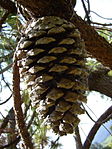en
names in breadcrumbs


Pinus devoniana is a species of conifer in the family Pinaceae. It is found in more than 15 states of Mexico - from S. Sinaloa to Chiapas - and Guatemala in montane, relatively open pine or pine-oak forests at altitudes from 900 to 2,500 m (3,000 to 8,200 ft).[3]
Pinus devoniana, which is locally called “pino blanco”, “pino lacio” or “pino prieto”, is a tree of medium size, which can grow 20–30 m (66–98 ft) tall, with a dbh to 80–100 cm (31–39 in). It has curved foliage twigs and very long needles, from 25–40 cm (9.8–15.7 in), in fascicles of 5. The cones, which grow solitary or in whorls of 2-4 on thick, short peduncles, leaving a few scales on the branch when falling, are usually large and often curved, 15–35 cm (5.9–13.8 in) long and 8–15 cm (3.1–5.9 in) wide when open.[4]
Pinus devoniana is closely related to Pinus montezumae (the Montezuma pine).[5] These species are sometimes difficult to distinguish, while hybrids probably occur. The cones are especially variable. Overall, both foliage and cones are larger in Pinus devoniana.[6]
Male strobili of Pinus devoniana at Hackfalls Arboretum
Pinus devoniana is a species of conifer in the family Pinaceae. It is found in more than 15 states of Mexico - from S. Sinaloa to Chiapas - and Guatemala in montane, relatively open pine or pine-oak forests at altitudes from 900 to 2,500 m (3,000 to 8,200 ft).
Pinus devoniana, which is locally called “pino blanco”, “pino lacio” or “pino prieto”, is a tree of medium size, which can grow 20–30 m (66–98 ft) tall, with a dbh to 80–100 cm (31–39 in). It has curved foliage twigs and very long needles, from 25–40 cm (9.8–15.7 in), in fascicles of 5. The cones, which grow solitary or in whorls of 2-4 on thick, short peduncles, leaving a few scales on the branch when falling, are usually large and often curved, 15–35 cm (5.9–13.8 in) long and 8–15 cm (3.1–5.9 in) wide when open.
Pinus devoniana is closely related to Pinus montezumae (the Montezuma pine). These species are sometimes difficult to distinguish, while hybrids probably occur. The cones are especially variable. Overall, both foliage and cones are larger in Pinus devoniana.

Cone

Male strobili of Pinus devoniana at Hackfalls Arboretum

Bark